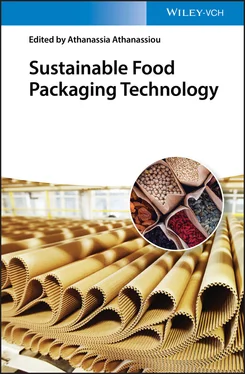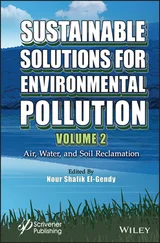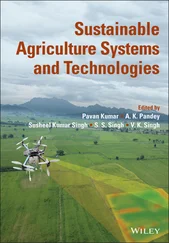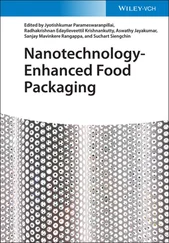1 ...6 7 8 10 11 12 ...25
1.3.3 Poly(butylene adipate‐ co ‐terephthalate)
Poly(butylene adipate‐ co ‐terephtalate) (PBAT) is a biodegradable aliphatic–aromatic copolymer, synthetized by the reactions of the monomer 1,4‐butanediol, adipic acid, and terephthalic acid. It is biocompatible and biodegradable, being degraded in a few weeks by lipases from Pseudomonas cepacia and Candida cylindracea [43]. Also, it is highly amorphous, it has high ductility and thermomechanical properties comparable with LDPE, and is compostable [44, 45]. Despite these suitable characteristics, PBAT shows a high permeability to water, that is, a poor water barrier property, and fails to achieve the mechanical strength required for some applications [46]. Different approaches have been considered to overcome these disadvantages, such as surface modifications, use of polymer blends, and reinforcement by fillers [47]. For instance, blends of PBAT with PLA can result in a biodegradable article with balanced mechanical properties, though the use of a chain extender or a cross‐linking agent to enhance the interfacial adhesion is usually necessary [48]. Also, the use of nanocomposites based on PBAT and layered silicates have yielded materials with improved mechanical properties [49].
PBAT films can be prepared using cast film extrusion, blown film extrusion, thermo‐compression, and solvent casting methods [50] and they can be used for agriculture, food packaging, waste and compost bags, among others [51]. PBAT is sold commercially by the trade names of Ecoflex® by BASF (Ludwigshafen, Germany), Easter Bio® from Eastman Chemical (Kingsport, USA), and Origo‐Bi® from Novamont (Novara, Italy). It is allowed for food packaging applications by the FDA [52, 53] and the incorporation of antimicrobial substances for active food packaging has recently shown very promising results to enhance food safety [54].
1.3.4 Polybutylene Succinate
Polybutylene succinate (PBS) is a biodegradable and compostable aliphatic polyester produced by polycondensation of succinic acid and 1,4‐butanediol. PBS was exclusively derived from petroleum‐based monomers, but since more recently the monomers can also be obtained by the bacterial fermentation route to produce fully bio‐based polybutylene succinate (bio‐PBS) [29, 55]. So far succinic acid has been mainly produced by electrochemical synthesis due to the high yield, low cost, high purity of the final product, and very low or no waste formation [56]. However, the production of succinic acid by bacterial fermentation uses renewable resources and consumes less energy compared to chemical process. For this reason, companies such as Corbion (Geleen, the Netherlands) and BASF are working on the scaling up of an economically feasible bio‐based succinate production process, despite the fact that these processes have traditionally suffered from poor productivity and high downstream processing costs. Other examples are the development of a biomass‐derived succinic acid production by Mitsubishi Chemical (Tokyo, Japan) in collaboration with Ajinomoto (Tokyo, Japan) to commercialize bio‐PBS or the development of a commercially feasible fermentation process for the production of succinic acid, 1,4‐butanediol, and the subsequent production of PBS by DSM (Heerlen, the Netherlands) and Roquette (Lestrem, France). Myriant (Quincy, USA) and Bioamber (Plymouth, USA) have also developed a fermentation technology to produce the monomers [57, 58]. Thus, in 2015, the annual production capacity of bio‐based succinic acid reached 200 000 tons [59]. In the case of 1,4‐butanediol, conventional production processes use fossil fuel feedstocks, such as acetylene and formaldehyde. Nevertheless, the bio‐based process to obtain the diol involves the use of glucose from renewable resources to produce succinic acid followed by a chemical reduction to produce butanediol [29]. PBS with excellent mechanical properties and processing capabilities can be then produced from the renewable monomers by transesterification, direct polymerization, and condensation polymerization reactions followed by chain extension and lipase‐catalyzed synthesis.
PBS is a semicrystalline aliphatic polyester with a good melt processability and balanced mechanical properties, closely comparable to those of PP. It is tougher than PLA and it shows similar thermal behavior than LDPE and a melting point lower than that of PLA [29, 60]. Its thermal and mechanical properties highly depend on the crystal structure and the degree of crystallinity [61]. The T gand T mare approximately −32 and 115 °C, respectively. In terms of mechanical properties, PBS has a good tensile and impact strength with moderate rigidity and hardness [29]. PBS has a wide processing window, which makes the resin suitable for extrusion, injection molding, thermoforming, fiber spinning, and film blowing. PBS has been employed as film, in foaming, and in food packaging containers [60]. However, the relatively poor mechanical flexibility of PBS limits the applications of 100% PBS‐based products. This issue can be overcome by blending PBS with other biopolymers and fillers to improve the mechanical properties to suit the required application and biodegradation rate [62–65]. The development of PBS copolymers can also lead to biopolymers with a decreased degree of crystallinity, depressed heat distortion temperature, and improved elongation [56, 66]. Copolymerization is achieved by adding a third monomer such as sebacic acid, adipic acid, terephthalic acid, succinic acid with substituted side groups, 1,3‐propanediol, and other substituted glycols, which can be also produced from renewable resources. Poly(butylene succinate‐ co ‐terephthalate) (PBST) and poly(butylene succinate‐ co ‐adipate) (PBSA) are the most employed copolymers, PBSA being the most common for flexible packaging applications. Additionally, the flexibility of the PBS backbone and the presence of readily hydrolyzable ester bonds, which are prone to catalytic degradation by microorganisms or enzymes, promote rapid degradation process of the PBS copolyesters [67]. Some studies have evaluated the biodegradability of biodegradable polymers in the mature compost soil and found that the biodegradability of PBS was slower than that of PBSA in compost soil [68]. However, the results of enzymatic hydrolysis as well as environmental degradation of PBS are highly dependent on the environment, the composition of the PBS grade, and its compound [55].
1.3.5 Bio‐based Polyethylene
Bio‐based polyethylene (bio‐PE), also called “microbial” or “green” polyethylene, can be produced by the catalytic dehydration of bioethanol obtained by microbial fermentation, followed by normal polymerization to produce polyethylene (PE) [69, 70]. Bio‐PE is not biodegradable and has the same properties as PE made from natural gas or oil feedstocks [29]. Conventional PE is manufactured by polymerization of ethylene under pressure, temperature, in the presence of a catalyst. Traditionally, ethylene is produced through steam cracking of naphtha or heavy oils or ethanol dehydration. However, the concept of producing PE from bioethanol is not particularly new. In the 1980s, Braskem (São Paulo, Brazil) had already made bio‐PE from bioethanol, however, the limitations of the biotechnology processes made the technology unattractive at that time [71]. Currently, bio‐PE produced on an industrial scale from bioethanol is derived from renewable feedstocks, including sugarcane and beet, starch crops such as maize, wood, wheat, corn, and other plant wastes through microbial strain and biological fermentation process. In a typical process, extracted sugarcane juice with high sucrose content is anaerobically fermented to produce ethanol. At the end of the fermentation process, ethanol is distilled in order to remove water and to yield an azeotropic mixture of hydrous ethanol. Ethanol is then dehydrated at high temperatures over a solid catalyst to produce ethylene and, subsequently, bio‐PE [69, 72]. Figure 1.4shows a schematic flow diagram of the bio‐PE production.
Читать дальше











